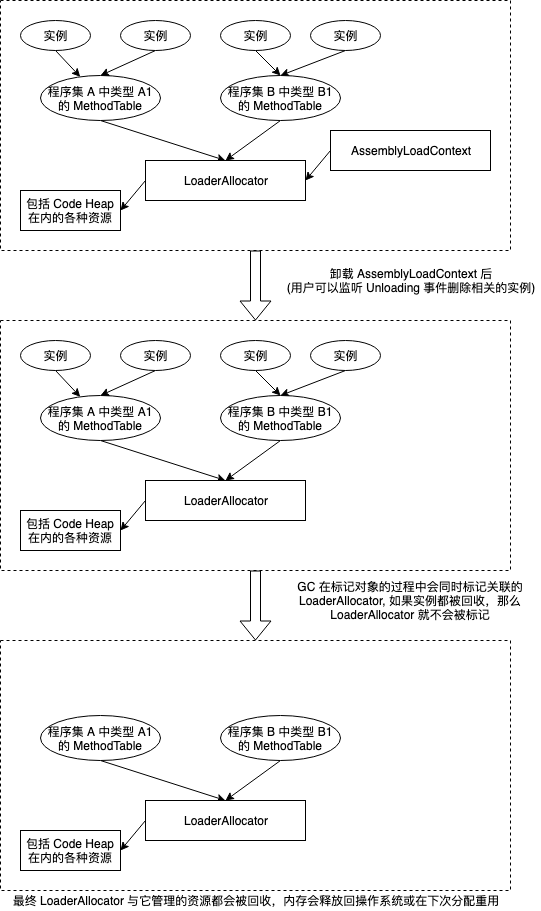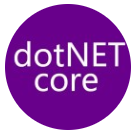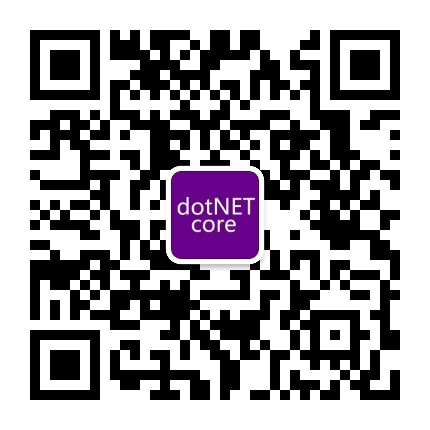文章转载授权级别:A 预计阅读时间:8分钟 损失发量:不好统计
因为最近在群里被问到如何理解 .NET Core 3.0 可卸载程序集,所以就写了这篇简单的分析。
因为时间实在很少,这篇文章只简单的罗列了相关的代码,请配合官方说明文档理解。
另外,书籍《.NET Core 底层原理》预计 11 月出版,出版社比较拖 :O。
Azulx: 昨晚下班群里问的农神,今早就出来了,这效率。
链接
可卸载程序集的官方说明文档如下:
https://github.com/dotnet/coreclr/blob/release/3.0/Documentation/design-docs/unloadability.md
程序集中的 IL 代码经过 JIT 编译后,会储存原生代码在 LoaderAllocator 管理的 Code Heap 中,LoaderAllocator 的代码地址如下:
https://github.com/dotnet/coreclr/blob/release/3.0/src/vm/loaderallocator.hpp
https://github.com/dotnet/coreclr/blob/release/3.0/src/vm/loaderallocator.cpp
https://github.com/dotnet/coreclr/blob/release/3.0/src/vm/loaderallocator.inl
负责分配原生代码的是 CodeManager ,代码地址如下:
https://github.com/dotnet/coreclr/blob/release/3.0/src/vm/codeman.h
https://github.com/dotnet/coreclr/blob/release/3.0/src/vm/codeman.cpp
GC 实现代码如下:
https://raw.githubusercontent.com/dotnet/coreclr/release/3.0/src/gc/gc.cpp
对象头 (MethodTable) 代码如下:
https://github.com/dotnet/coreclr/blob/release/3.0/src/vm/methodtable.h
https://github.com/dotnet/coreclr/blob/release/3.0/src/vm/methodtable.inl
https://github.com/dotnet/coreclr/blob/release/3.0/src/vm/methodtable.cpp
AssemblyLoadContext 的代码如下:
https://github.com/dotnet/coreclr/blob/release/3.0/src/System.Private.CoreLib/shared/System/Runtime/Loader/AssemblyLoadContext.cs
分析
在 .NET Core 中我们不能新建 AppDomain (尽管有默认的几个 AppDomain),程序集会通过 AssemblyLoadContext 管理。简单的来说,AssemblyLoadContext 负责管理有依赖关系的一组程序集,例如程序集 A 依赖程序集 B,那么 A 和 B 需要使用同一个 AssemblyLoadContext 加载。每个 AssemblyLoadContext 都会关联不同的 LoaderAllocator,也就是拥有不同的 Code Heap。
.NET Core 3.0 开始允许卸载用户创建的 AssemblyLoadContext ,也就是回收 AssemblyLoadContext 为程序集分配的各种资源,包括 JIT 生成的原生代码,PreCode,类型元数据等,流程大致如下:
用户创建 AssemblyLoadContext (isCollectible = true)
用户使用 AssemblyLoadContext 加载程序集 A
用户使用 AssemblyLoadContext 加载程序集 B
用户创建程序集 A 和 B 中的类型的实例,并执行其中的方法
用户卸载 AssemblyLoadContext
.NET Core 等待所有程序集 A 和 B 中的类型的实例都被回收后,释放 AssemblyLoadContext 管理的 LoaderAllocator 分配的资源
可以参考下图理解 (这是经过简化的流程,详细流程可以看前面给出的官方说明文档链接):

卸载 AssemblyLoadContext 时,取消对 LoaderAllocator 的关联的代码如下:
https://github.com/dotnet/coreclr/blob/release/3.0/src/binder/clrprivbinderassemblyloadcontext.cpp#L276
GC 标记对象时,同时标记关联的 LoaderAllocator 的代码如下 (在 gc.cpp 里面):
#define go_through_object_cl(mt,o,size,parm,exp)
{ // 如果对象的 MethodTable 是由可回收的 AssemblyLoadContext 加载的 if (header(o)->Collectible()) { // 获取关联的 LoaderAllocator uint8_t* class_obj = get_class_object (o); uint8_t** parm = &class_obj; // 标记 LoaderAllocator (根据 exp 的具体逻辑而定) do {exp} while (false); } // 如果对象包含引用类型的成员 if (header(o)->ContainsPointers()) { go_through_object_nostart(mt,o,size,parm,exp); }
}// 调用 MethodTable::GetLoaderAllocatorObjectForGC
#define get_class_object(i) GCToEEInterface::GetLoaderAllocatorObjectForGC((Object *)i)LoaderAllocator 被回收以后到释放资源的相关代码 (被回收之前的逻辑参考官方说明文档):
https://github.com/dotnet/coreclr/blob/release/3.0/src/vm/loaderallocator.cpp#L520
https://github.com/dotnet/coreclr/blob/release/3.0/src/vm/appdomain.cpp#L857
https://github.com/dotnet/coreclr/blob/release/3.0/src/vm/appdomain.cpp#L817
https://github.com/dotnet/coreclr/blob/release/3.0/src/vm/appdomain.hpp#L3086
https://github.com/dotnet/coreclr/blob/release/3.0/src/vm/appdomain.cpp#L6240
https://github.com/dotnet/coreclr/blob/release/3.0/src/vm/appdomain.cpp#L6283
https://github.com/dotnet/coreclr/blob/release/3.0/src/vm/loaderallocator.cpp#L88
https://github.com/dotnet/coreclr/blob/release/3.0/src/vm/loaderallocator.cpp#L1301
说明就到此为止了。你可能会奇怪为什么这篇文章没有提到 Assembly 和 DomainAssembly ,这是因为它们在可卸载程序集的实现中并不重要,资源是通过 AssemblyLoadContext 关联的 LoaderAllocator 统一分配和释放的,与其说是可卸载程序集,不如说是可卸载程序集加载上下文 (AssemblyLoadContext)。
https://github.com/dotnetcore
打赏一杯酒,削减三分愁。跟着我们走,脱发包你有。





 微信ID:OpenNCC
微信ID:OpenNCC 长按左侧二维码关注
长按左侧二维码关注欢迎打赏组织
给予我们更多的支持
![P4331 [BalticOI 2004]Sequence 数字序列(左偏树)](http://pic.xiahunao.cn/P4331 [BalticOI 2004]Sequence 数字序列(左偏树))

(树套树))


(线段树))

)
(2016ICPC青岛K)(K-D Tree))





)



)
